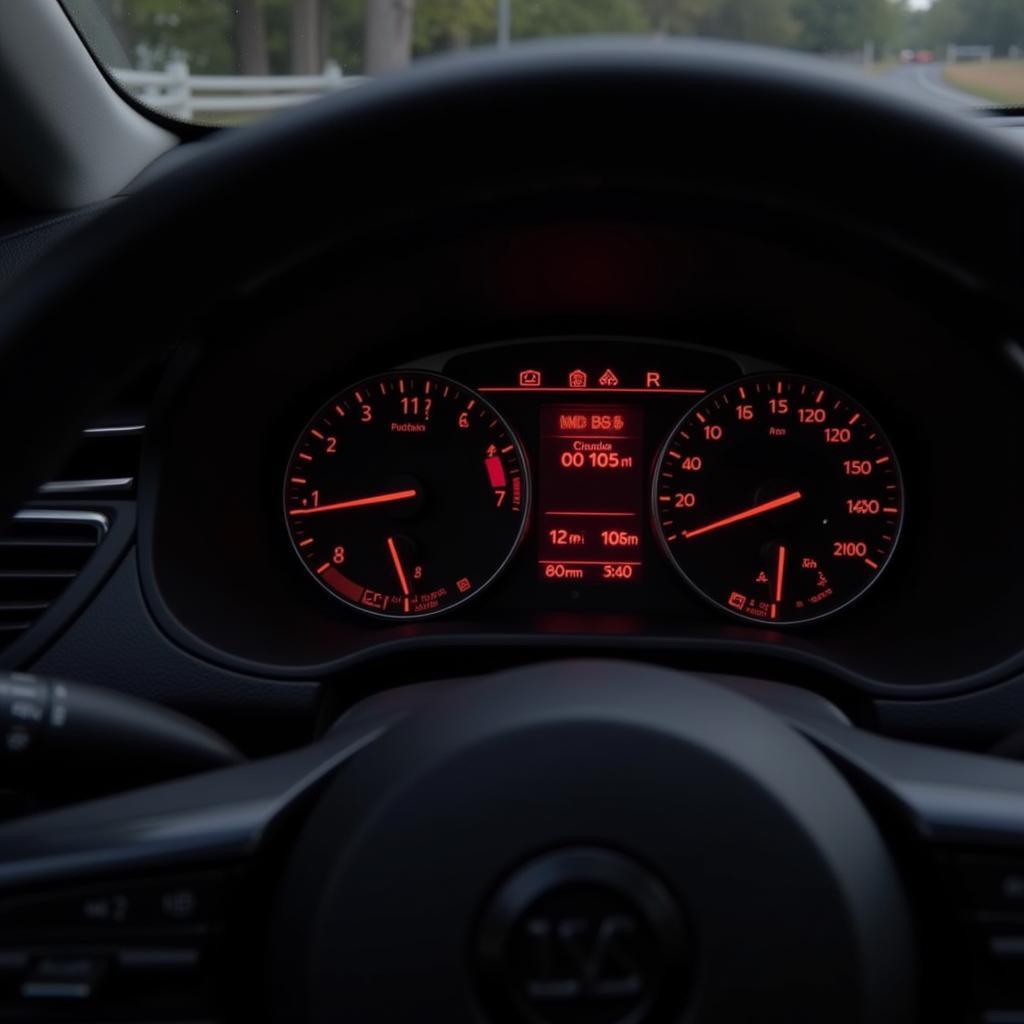A glowing brake warning light on your Saab’s dashboard is a cause for concern, but don’t panic. This common issue doesn’t always signal a catastrophic failure. This comprehensive guide explores the various reasons behind Saab brake warning lights and provides potential solutions to get you back on the road safely.
Understanding Your Saab’s Brake Warning System
Saab vehicles, known for their safety features, utilize a sophisticated brake warning system to alert drivers of potential issues. When the system detects a fault, the brake warning light on your dashboard illuminates, often accompanied by a message on the Driver Information Center (DIC). Ignoring this warning could lead to decreased braking performance and potentially dangerous situations.
Common Causes of Saab Brake Warning Lights
Several factors can trigger the brake warning light in your Saab. Let’s delve into the most common culprits:
1. Low Brake Fluid Level
One of the most frequent reasons for the brake warning light is a low brake fluid level. Brake fluid is the lifeblood of your car’s braking system, transmitting force from the brake pedal to the wheels. A leak in the system can cause the fluid level to drop, triggering the warning light.
What to do: If you suspect a brake fluid leak, it’s crucial to inspect the brake lines, hoses, and calipers for any signs of leakage. If you notice any leaks, it’s essential to address them immediately and refill the brake fluid to the appropriate level. However, it’s best to have a professional mechanic diagnose and repair the leak to ensure your safety.
2. Worn Brake Pads
Brake pads are designed to wear down over time. When they reach a certain thickness, the brake pad wear sensor, usually a small metal tab embedded within the pad, makes contact with the brake rotor, completing an electrical circuit and illuminating the brake warning light.
What to do: Worn brake pads require immediate attention. Continuing to drive with worn pads can damage the rotors, leading to costly repairs. It’s crucial to have your brake pads inspected and replaced by a qualified mechanic, preferably using genuine Saab parts.
3. Faulty ABS System
Saab vehicles are equipped with Anti-lock Braking Systems (ABS) that prevent wheel lock-up during hard braking, enhancing vehicle control. If the ABS system malfunctions, it can trigger the brake warning light.
What to do: A faulty ABS system requires professional diagnosis using a scan tool to read the error codes. The issue could range from a faulty wheel speed sensor to a problem with the ABS module itself. Addressing ABS issues promptly ensures optimal braking performance and safety.
4. Brake Light Switch Malfunction
Though not directly related to the braking system’s hydraulics, a malfunctioning brake light switch can also trigger the brake warning light. This switch activates the brake lights when you press the brake pedal. If the switch fails, it can disrupt the signal to the brake warning system.
What to do: A faulty brake light switch is usually a simple and inexpensive fix. A mechanic can test the switch and replace it if necessary, restoring both the brake lights and the warning system’s functionality.
5. Electrical Issues
Electrical problems, such as a blown fuse, loose wiring, or a faulty sensor, can disrupt the brake warning system, causing the light to illuminate.
What to do: Diagnosing electrical problems requires expertise. A qualified mechanic can inspect the wiring, check for blown fuses, and test the sensors to pinpoint the source of the issue and implement the necessary repairs.
Addressing Saab Brake Warning Lights
Attempting to diagnose and repair brake system issues yourself can be dangerous. If your Saab’s brake warning light comes on, it’s crucial to seek professional help immediately. Ignoring the warning light can jeopardize your safety and lead to more extensive and expensive repairs in the long run.
Remote Diagnostics and Programming for Saab Vehicles
In today’s technologically advanced world, remote diagnostics and programming have emerged as valuable tools for diagnosing and addressing car problems, including those related to Saab brake warning lights.
For instance, if you’re experiencing a 2003 Ford Focus brake warning light stays on, remote diagnostics can help identify the root cause. Similarly, if your 2002 Ford Focus brake warning light is flashing, remote diagnostics can pinpoint the issue.
Remote diagnostics can read your Saab’s onboard computer, retrieving error codes that provide insights into the potential causes of the brake warning light. This information is then relayed to skilled technicians who can remotely analyze the data, offer guidance, and in some cases, even reprogram certain modules to resolve the issue.
While remote diagnostics and programming offer a convenient and efficient solution for specific car problems, it’s essential to remember that some issues still require hands-on inspection and repair.
Conclusion
A glowing brake warning light in your Saab is a clear signal that something requires attention. Whether it’s a simple issue like worn brake pads or a more complex problem with the ABS system, it’s crucial to address it promptly to ensure your safety and prevent further damage to your vehicle. Consulting a qualified Saab mechanic and considering the benefits of remote diagnostics can help you navigate brake warning light issues effectively and get back on the road with confidence.

